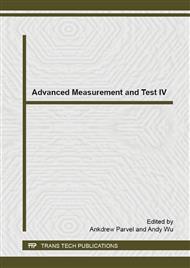p.90
p.97
p.104
p.111
p.121
p.127
p.131
p.137
p.142
A Research on High-Precision Strain Measurement Based on FBG with Temperature Compensation
Abstract:
FBG (Fiber Bragg Grating) is a new type of optical passive device which can be used in sensing field. This paper demonstrates the feasibility and effectiveness of FBG as the new method of strain measurement, and improves the measuring precision. Based on the strain sensing property of FBG, the study adopts the differential method of double FBGs to make temperature compensation, and conduct the contrast experiment with resistance strain chip. The experimental results show that strain measurement based on FBG agrees well with theoretical calculation. The measurement error: no more than 1%, linear fitting correlation coefficient: almost 1, linearity: 0.17%, sensitivity: 7.92, hysteresis error: 0.347%, repeatability error: 0.333%. The results show FBG’s performance are superior to resistance strain chip, especially in aspect of measuring precision. Therefore, we can conclude that FBG is a feasible and effective method of strain measurement.
Info:
Periodical:
Pages:
121-126
Citation:
Online since:
January 2015
Authors:
Price:
Сopyright:
© 2015 Trans Tech Publications Ltd. All Rights Reserved
Share:
Citation:


